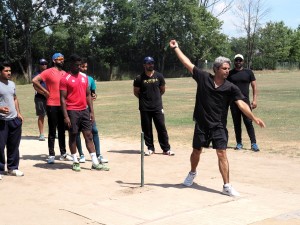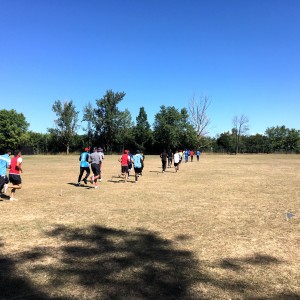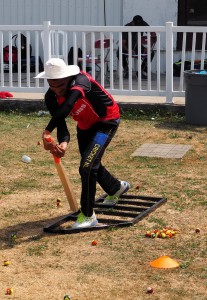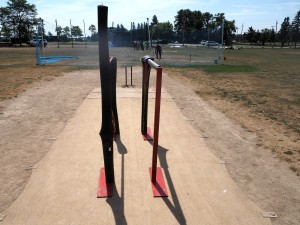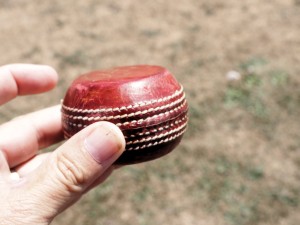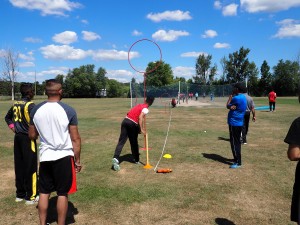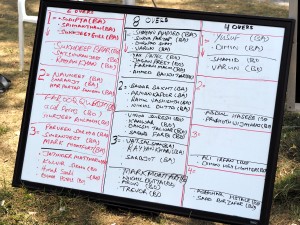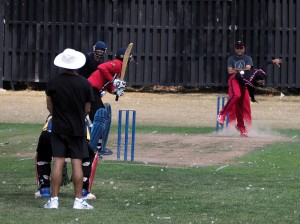
A report from Dave Liverman, exclusive to Canada Cricket Online
Cricket Canada announced in June of this year that Zubin Bharucha had been appointed to direct Cricket Canada’s High Performance programme. Over the summer, national team selectors had been visiting regional tournaments and recommended players to be considered as part of this programme. In late July, players were invited to attend the high performance camp, to be held over two weeks in early August. The players were allocated to three groups – the HP development group (largely younger players considered to have the potential to play international cricket), The High Performance group (players considered to have the ability to challenge for national team places), and the senior national team. Development players were charged $500 to attend the camp. Players from outside Ontario received assistance with travel, hotel and local transport.
In addition, coaches from the regions were invited to attend, with the objective of learning Zubin’s methods and working with HP players in their regions in the future. I was fortunate enough to be invited to attend the camp in a coaching capacity, and Cricket Canada provide permission for me to write about the experience.
The following is very much a personal impression of the camp, and should not be interpreted as an official report or representing Cricket Canada in any way- I am grateful to the organization for the opportunity to observe and write about the camp
The first week of the camp was attended by development group players from the Toronto area, mostly U19 and U17 age group – I was told this went well.
The second half of the camp featured mainly cricketers from outside the Toronto area, extending from coast to coast- BC to Newfoundland. There were three groups in attendance – the high performance group, consisting of national team squad members, plus other cricketers identified as having the potential to play at national level; the high performance development group – mostly younger cricketers who had excelled at youth level; and coaches from across the country, with representatives from Saskatchewan, BC, Alberta, New Brunswick and Newfoundland. They were joined by Toronto based national team squad members on some days. This resulted in around 45 players being involved most days.
I was able to talk to Zubin about his interest in and philosophy of coaching. He started coaching at 16 years old, when playing as a professional in England. Games were only on the weekend, so during the week he started coaching youth teams; this has been the start of a long career. In terms of coaching, he tries to emphasize the fundamentals of the game, even when coaching international players. He use the basic drills demonstrated at the camp when working at the highest levels. He believes in intensive, focused and effective practice with clear goals and objectives. He also wants to give the players the tools to work on their own development, and emphasizes that they need to show real commitment in order to improve.
The sessions were intense, and each group was allocated half a day for the first two days. The high performance group was up first, on a blisteringly hot day at Maple Leaf CC. The group was first addressed by Cricket Canada president, Ranjit Saini, who emphasized the opportunities open to those there, and the need to build a strong national team. He then introduced Zubin Bharucha to lead the sessions, assisted by former national team members Henry Osinde, Khurram Chouhan who are also national selectors and high performance coaches.
Zubin Bharucha is a fit 47 years old, and started the session by leading a “short run” – 5 laps of the field, with players 30 years his junior challenged to keep up with him. This exercise effectively demonstrated the importance of fitness, and in some cases the work the players needed to do to achieve the expected levels. He followed this with an exercise where the players had to complete 12 22 yard runs and turns in one minute, followed by a minute recovery, then a repeat. The expectations are that players should be fit enough to complete 5 sets of runs/ recovery.
The sessions emphasized skill development based on sound fundamentals. Innovative, but simple equipment helped the players focus on these. The players used custom made grids, narrow bats (half the width of a standard bat) and small balls to work on footwork, correct head positioning, and specifically ensuring the bat and body were correctly positioned to allow play to both sides of the wicket off the front foot. There was a strong emphasis on footwork, particularly in moving the foot towards the pitch of the ball, with exercises where the batsman had to trap a ball fed to them with their foot as it bounced.
The groups then split into three; batsmen, fast, and spin bowlers. The bats continued to work with the thin bats, this time with tennis balls, focusing on back foot shots. The batsman were asked to play tennis balls thrown underarm to above the waist, particularly using footwork to get square and behind the ball to open up the on side. They also worked at picking the bouncer and avoiding it.
The bowlers used some custom built apparatus to focus their practice, again working on basics. The fast bowlers were faced with a padded frame, placed around the area of a perfect length, consisting of two uprights spaced about the wicket’s width apart. They were asked to bowl with pace, pitching the ball within the area marked by the frame, but with no run up at all. This forced them to focus on the basic biomechanics of their delivery, as well as on accuracy. The exercise was varied by asking them to perform the same exercise from 24 and 30 yards, by bowling from two steps, and by using special practice balls flattened on either side of the seam. They graduated to working with their full run up. The “flat” balls emphasised bowling with an upright seam position with control. This simple exercise proved surprisingly challenging for most of the bowlers, but the focused practice resulted in notable improvements from day to day.
The spinners worked on flight, dip and accuracy using an apparatus consisting of three hoops, one near the bowler at a height of 8-13 feet, one at chest height about 5 yards from the target stumps, and a third “target” hoop on a good length. The objective was to propel the ball through both standing hoops to land in the third, initially without any run up at all, later from two steps and the full run up. Further work consisted of trying to hit a hoop target laid on the ground from 24 and 30 yards with minimal run up.
The batting and bowling drills were varied with some simple fielding/ coordination drills using tennis balls. These were conducted in pairs. The players enjoyed a basic catching drill in which one player stood with his back to his partner, about 5 metres away, and on a call to turn would rapidly turn 180 degrees and attempt to catch the ball, often already in flight prior to the call. Another drill consisted on working on basic throwing mechanics and accuracy- players about 15 yards from each other and aiming to throw a ball directly into the hands of their partner, requiring as little movement to catch as possible. Former national team captain Farooq Kirmani, and Zubin Surkari also worked with the players on more conventional fielding practice.
After two days working on drills, the sessions switched to the field, with players tasked with playing out scenarios. A typical scenario consisted of a set number of overs, with three bowlers and three bats, and a set target of runs to try and achieve. For instance, one scenario was the opening 6 overs of the match, with only two deep fielders out, and a new ball. Three pace bowers bowled two overs each, trying to restrict scoring and take wickets, while three batsmen tried to achieve a target of 45 runs. If the batting group lost two wickets then they had failed to achieve their objectives. Other scenarios dealt with middle overs of a T20, and the death overs.
For the first day of the scenarios all groups were mixed together, meaning at times players from the development group were facing national team members. It was another very hot day, and in order to give all players an opportunity to try a scenario, a long one, given there were close to 45 players involved. The matches took place on a turf pitch, which unfortunately, due to issues with water at King City, was slow and dry, and strongly favoured the spinners with significant turn. Zubin closely observed the action from a position just behind the keeper, and constantly moved the field around, to set both batsmen and bowlers challenges.
It was clear that not all players could translate the improvement seen in drills to the field, with some fast bowlers losing the accuracy they had worked on in practice, and many batsmen failing to adapt their game to the scenario posed. There were some excellent performances as well, particularly from spinners enjoying the favourable conditions.
The second day of scenarios was split into two groups, the morning group consisting mostly of senior team and HP group members, and a longer session in the afternoon for the rest. Given the state of the turf wickets, it was decided to switch to a matting pitch, less than ideal for players who need to be used to natural turf wickets, but a far more even contest between bat and ball.
The last, short day, was restricted to players from outside of Ontario, and was a combination of drills, and individual feedback to each player from Zubin, giving them areas to focus on for development.
Some reflections on the camp
Again these are very much personal opinions, and not in any way representative of Cricket Canada.
- Zubin is an excellent coach, a good communicator, and the players had much to learn from him. The former national team players also made useful contributions.
- The drills Zubin used for the most part are useful at almost any level of cricket, will be easy to apply regionally, and are designed to ensure solid fundamentals.
- I had last been at King City in 2001 for the ICC Trophy; it’s current state emphasizes the paucity of basic cricket infrastructure in Canada. The clubhouse is looking rather run down, the outfields could be far better, but the main issue is the lack of high quality turf pitches. I understand that the pitch used was below the usual standard at King City, due to lack of time to prepare and a water shortage, but the inability to have a decent pitch in place for the camp does point to problems at Canada’s international home.
- Although the participants were told this was a training camp, not a selection camp, it was clear that selection was taking place, with national selectors watching and taking notes. The format of the camp was for training, not selection, and players really did not have much opportunity to be evaluated. The number of participants and the scenario format meant that bowlers only bowled 12 to 24 balls in match settings, with bats getting similar brief opportunities. All participants had been seen by the selectors in regional competition but not when facing higher quality opposition. I suspect that some players felt frustrated at the lack of opportunity to show their skills. I was later told that the selection process was simply ensuring that players were assigned to the correct groups- original invitations were based on the potential seen in the players, and in future players will move between the groups depending on personal efforts and proficiency achieved.
- Players were only on the field for half days, which given the very high heat was reasonable, but given they had been flown in from all over the country, it would be good to have lecture/ classroom sessions for them to fill the days. There were no nets available at King City for practice, although some players chose to use spare matting wickets to practice on their own.
- The rapid manner in which the camp was put together was apparent in that players were not originally clear on the objectives of the camp, and the expectations of them. I believe that most of them found the camp useful, particularly those who get little experience of high level cricket who could see the standard across /Canada, and were able to measure themselves against it. The lack of a clear schedule or plan likely reflects the short notice in putting the camp together.
What next?
The main objective of the camp was to give coaches and players insight into the training required for high level cricketers in Canada. Cricket Canada will shortly be launching a new web site, and high performance training will be integrated into this, with training plans, player monitoring, and more. It is expected that coaches will work on developing regional training centres and academies for player development.
Zubin Bharucha will remain closely involved with the programme – he is based in the US but travels frequently all over the world for coaching work. Players considered part of the senior national squad will work for a further week with Zubin in late August, and Zubin will work closely with the selectors and national coach going forward.
It is planned that the three groups (national squad, high performance and development) will be brought together to play matches in the future, preferably also involving high quality opponent from outside Canada- perhaps full member A teams. This will provide opportunities for players to demonstrate their abilities in match situations, and provide opportunities for them to move up through the system.
Cricket Canada of course faces many challenges in supporting this programme, with money being by far the greatest. Canada’s geography means that travel costs remain high, and infrastructure requires a major investment. It will be interesting to follow progress over the next year.
Cricket Canada president Ranjit Saini told me that “I can assure this to all players that they could go to national team level in very little time… The selection system is now very much in control of the players themselves. It will be up to the players to train and achieve their proper place. Cricket Canada has gone out and provided the most fair and transparent selection system in any given cricket nation at our level. “

